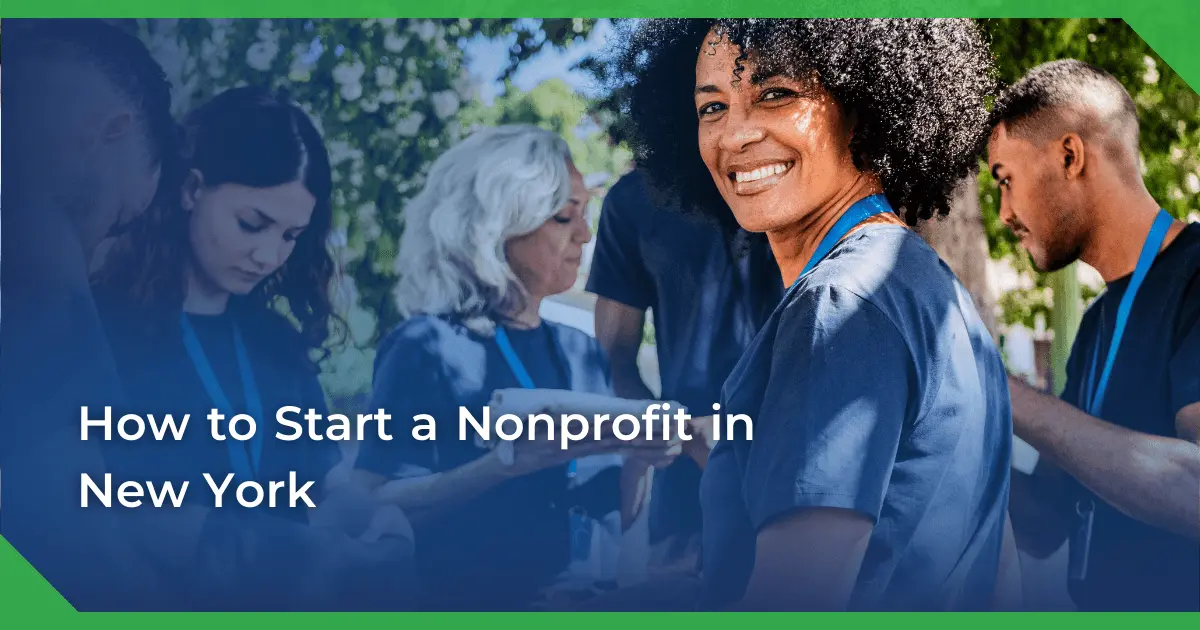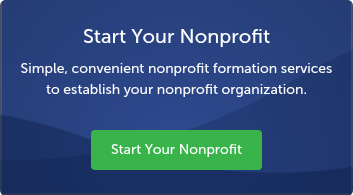How to Start a Nonprofit in New York: A Step-by-Step Guide

Whether you dream of fighting hunger, supporting the arts, or championing education, starting a nonprofit in New York could be your path to creating lasting change. But here’s the truth – while the impact potential is huge, the process can feel overwhelming without the right guidance.
That’s exactly why we’ve created this comprehensive guide. From choosing your nonprofit structure to securing tax exemptions, we’ll walk you through every step of forming your nonprofit in New York. No confusing legal jargon, just clear, actionable steps that actually work.
Ready to turn your vision into reality and make a difference in your community? Let’s get started!
Check If Starting a Nonprofit is Right for You
Starting a nonprofit requires more than just passion and good intentions. Before diving into the paperwork and legal requirements, take time to evaluate if establishing a nonprofit is the right path for your mission.
Key questions to ask yourself
First, identify the specific need your nonprofit will address. Therefore, consider these critical questions:
- What concrete problem are you trying to solve?
- Who specifically will benefit from your services?
- Do you have proof of community need for these services?
- What skills and experience do you bring to lead this initiative?
- Can you sustain the organization financially?
Research shows that 62% of Black, Indigenous, and people of color-led nonprofits in New York have 3 months or less of cash reserves Nonprofit Finance Fund. This highlights the importance of having a solid financial foundation before launching.
Additionally, examine if other organizations already provide similar services in your area. With more than 1.5 million nonprofits in the United States competing for attention and resources National Council of Nonprofits, your organization needs a clear differentiator to succeed.
Alternative options to consider
Instead of starting a new nonprofit, several effective alternatives might better serve your mission:
- Join an Existing Organization: Consider volunteering, joining the board, or becoming staff at an established nonprofit. This allows you to gain experience while contributing to the cause immediately.
- Create a Special Program: Partner with an existing nonprofit to launch your initiative under their umbrella. This approach provides:
- Access to established infrastructure
- Freedom from separate bookkeeping requirements
- Relief from government reporting obligations
- Ability to focus on direct service rather than administrative tasks
- Fiscal Sponsorship: This arrangement lets you operate under an existing nonprofit’s tax-exempt status. Fiscal sponsors typically:
- Provide administrative and accounting services
- Offer strategic planning guidance
- Charge around 10% of revenues for their services Minnesota Council of Nonprofits
- Help with co-location opportunities
- Start a Local Chapter: Many national organizations welcome new local chapters. This option provides:
- Established brand recognition
- Proven operational models
- Support systems and resources
- Guidance for local implementation
- Form an Unincorporated Association: For small, local efforts, operating as an unincorporated association might suffice. Nevertheless, remember that this structure doesn’t provide liability protection for personal assets Minnesota Council of Nonprofits.
Nonprofits employ more than 18% of NYC workers and contribute over $77 billion annually to the city’s economy Nonprofit Finance Fund. Subsequently, choosing the right organizational structure is crucial not just for your mission, but for the broader community impact.
Remember that charitable organizations must serve a defined “charitable class” – a specific group who will receive assistance from your programs. Furthermore, you’ll need a concrete plan to present to the IRS when applying for tax-exempt status Charitable Allies.
Before proceeding, ensure you understand the ongoing reporting and record-keeping requirements. These obligations demand substantial time and financial commitments, which can distract from your primary mission of serving people, creating art, or promoting a cause Minnesota Council of Nonprofits.
Plan Your Nonprofit’s Foundation
You’ve outlined community needs and drafted a mission statement. Now what? Let’s tackle the state filings that move you forward.
Define your mission and vision
Your mission statement serves as the cornerstone of your nonprofit, clearly expressing your organization’s purpose and goals. An effective mission statement should be:
- Concise and memorable
- Written in active voice
- Free from technical jargon
- Focused on your core purpose
Moreover, your vision statement should paint a picture of the ideal future your organization aims to create. Although both statements might seem similar, they serve different purposes. Your mission defines your current purpose, whereas your vision describes the world you aspire to create through your work The Bridgespan Group.
Research similar organizations
Understanding the nonprofit landscape in New York helps you position your organization effectively. Use these strategies to conduct thorough research:
- Examine GuideStar profiles of similar nonprofits
- Review Form 990 tax returns
- Analyze programs and services offered
- Study funding sources and financial models
Since New York houses numerous charitable organizations, focus on identifying gaps in services or unique approaches to addressing community needs Marxe School of Public and International Affairs. This research phase also presents opportunities to discover potential partnerships or collaborative ventures that could amplify your impact BoardSource.
Create a basic business plan
A comprehensive business plan outlines how your nonprofit will operate and achieve its objectives. Your plan should address these essential components National Council of Nonprofits:
- Market Analysis: Detail your target audience, community needs, and potential competitors
- Operational Strategy: Explain how you’ll deliver programs and measure impact
- Financial Projections: Include expected income sources, operational costs, and program expenses
- Resource Requirements: List needed staff, volunteers, and material resources
Your business plan serves as more than just a document – it becomes your roadmap for decision-making and resource allocation Donorbox. As a result, ensure it remains flexible enough to adapt to changing circumstances yet structured enough to provide clear direction.
Remember to include contingency plans and assumptions that might affect your organization’s financial health National Council of Nonprofits. This forward-thinking approach helps prepare for various scenarios and demonstrates thorough planning to potential donors and supporters.
Complete the Legal Requirements
Navigating New York’s legal requirements marks a crucial phase in establishing your nonprofit. The state offers specific pathways for different types of organizations, consequently shaping how you’ll structure and register your entity.
Choose your nonprofit structure
New York recognizes four distinct classifications for nonprofits:
- Type A: For non-business purposes like civic, patriotic, social, or athletic organizations
- Type B: Focused on charitable, educational, religious, or scientific missions
- Type C: Serving public or quasi-public purposes typically handled by businesses
- Type D: Other specified purposes
Organizations combining multiple types automatically classify as Type B or C, depending on their primary purpose Harbor Compliance.
File formation documents
The Certificate of Incorporation serves as your nonprofit’s birth certificate. To file successfully:
- Select an available business name that meets state requirements
- Prepare the certificate with:
- Organization name and address
- At least three independent directors (aligning with IRS standards)
- Clear statement of nonprofit purposes
- IRS-approved purpose clause
- Dissolution clause (required for 501(c)(3) eligibility)
The filing fee amounts to $75, plus optional expedited processing fees ranging from $25 to $150 for faster turnaround Harbor Compliance. Upon acceptance, the New York Department of State (dos.ny.gov) issues an official filing receipt marking your incorporation date.
Rather than navigating these requirements alone, we handle everything from drafting your Certificate of Incorporation to ensuring compliance with New York’s specific regulations. Our state-specific drop-off service can even expedite your filing for faster processing where permitted.
Apply for tax exemptions
Formation alone does not make donations tax-deductible. You must secure tax-exempt status through multiple steps at federal and state levels:
First, obtain an Employer Identification Number (EIN) through the IRS. This nine-digit identifier proves essential for:
- Opening bank accounts
- Submitting tax returns
- Applying for 501(c)(3) status
We include EIN acquisition as part of our comprehensive formation services, eliminating one more step from your to-do list.
Next, file Form 1023 or 1023-EZ with the IRS for federal tax-exempt status. The streamlined 1023-EZ option costs $275 National Council of Nonprofits, primarily suited for smaller organizations expecting annual gross receipts under $50,000 Nixon Peabody. Standard Form 1023 carries a $600 filing fee Wolters Kluwer.
Following federal approval, pursue New York state tax exemptions:
- Submit Form CT-247 for corporation franchise tax exemption
- File Form ST-119.2 for sales tax exemption Harbor Compliance
Organizations must file within 27 months of incorporation to receive retroactive tax-exempt status Nixon Peabody. The entire process typically spans 6-12 months due to processing backlogs NYCON.
Remember that tax exemption doesn’t automatically transfer between federal and state levels. Each requires separate applications and ongoing compliance measures. With our 100% money-back guaranteed 501(c)(3) approval, you can proceed with confidence knowing experienced specialists manage every detail—from initial incorporation through IRS approval. Track your progress in real-time through our secure SOC 2 Type II certified client portal.
Set Up Essential Operations
After securing legal status, establishing robust operational foundations becomes vital for your nonprofit’s success. From assembling a dedicated board to creating essential documents, each step shapes your organization’s future.
Build your board of directors
New York law mandates a minimum of three board members for charitable corporations Office of the New York State Attorney General. These directors serve as fiduciaries, steering the organization toward sustainable growth through ethical governance and sound financial management.
When selecting board members, prioritize:
- Passion for your mission
- Business acumen for financial decisions
- Diverse skills supporting fundraising and programs
- High standards of integrity
- Independence from family or business ties
Your board must approve officer compensation through majority vote, unless bylaws delegate this to a committee Office of the New York State Attorney General. For transparency, document all compensation decisions, including:
- Comparability data from similar organizations
- Complete benefits package evaluation
- Basis for determination
- Meeting minutes recording the process
Create governing documents
Governing documents establish your nonprofit’s operational framework. These essential documents include:
Bylaws: Your organization’s internal manual that outlines:
- Meeting frequencies and procedures
- Board member roles and responsibilities
- Voting protocols
- Officer selection methods
- Amendment procedures
- Decision-making processes
Conflict of Interest Policy: This document helps identify and manage potential conflicts, ensuring board members act in the organization’s best interest rather than personal gain.
Document Retention Policy: Establish guidelines for maintaining and protecting important records. Your nonprofit must keep accurate accounts and complete minutes of all board and executive committee meetings Office of the New York State Attorney General.
Whistleblower Protection Policy: Create safeguards for individuals reporting suspected financial improprieties or other misconduct.
Our Nonprofit Compliance Specialists draft all required governing documents tailored to your organization’s specific needs and New York state requirements, ensuring nothing falls through the cracks during this critical setup phase.
Open bank accounts
Setting up dedicated bank accounts separates your nonprofit’s finances from personal assets. To open an account, you’ll need:
- Certificate of Incorporation
- Employer Identification Number (EIN)
- List of officers with:
- Government-issued photo ID
- Social Security numbers
- Additional identification proof
Most banks offer specialized nonprofit checking accounts featuring:
- Low or no monthly maintenance fees
- Online banking with bill pay
- Fraud prevention tools
- Remote check deposit capabilities
- Overdraft protection options
Remember that charitable organizations cannot lend money to officers or directors Office of the New York State Attorney General. Likewise, ensure proper tracking of restricted gifts and maintain separate accounts for such assets. Your treasurer must provide annual reports to the board regarding restricted funds, their use, and generated income Office of the New York State Attorney General.
The board should regularly review and update these operational foundations as your organization grows. Through careful attention to these essential components, you create a strong framework for achieving your charitable mission effectively and sustainably.
Start Your Fundraising Journey
Securing sustainable funding forms the backbone of your nonprofit’s ability to serve its mission. First, understand the legal requirements for fundraising in New York, then develop diverse revenue streams to support your work.
Register for charitable solicitation
Most organizations holding charitable assets or engaging in charitable activities in New York must register with the Charities Bureau Office of the New York State Attorney General. Charitable registration to fundraise is a separate filing, not granted automatically with your nonprofit formation or tax exemption.
To complete your registration, prepare these essential documents:
- Employer identification number (EIN)
- Certificate of incorporation
- Bylaws
- Two authorized signatories:
- Organization’s president or authorized officer
- Chief financial officer or treasurer
Certain organizations qualify for exemption from registration, primarily:
- Religious organizations and their charitable arms
- Membership organizations not soliciting from the public
- Parent-teacher associations
- Educational institutions filing with the NY Department of Education
- Government agencies Office of the New York State Attorney General
Upon registration, your nonprofit must file annual financial reports with the Office of the New York State Attorney General Office of the New York State Attorney General. For organizations soliciting donations in New York but incorporated elsewhere, submit an Application for Authority with the Department of State 501c3.org.
Navigating these requirements can be complex, but comprehensive compliance from charitable solicitation to corporate filings becomes manageable with the right partner. We include bundled services such as first-year fundraising registration, eliminating the need to manage multiple vendors when expert support handles it all through one secure portal.
Plan initial funding sources
Studies indicate that 76% of nonprofits face challenges in securing funding WildApricot. To overcome this hurdle, consider implementing multiple revenue streams:
Membership Programs
Create tiered membership levels offering various benefits. This approach generates reliable, recurring revenue through predictable fee structures.
Individual Donations
Build a robust donor stewardship program focusing on:
- Regular communication
- Impact reporting
- Personalized engagement
- Recognition programs
Grant Opportunities
Explore funding from:
- Local government programs
- State initiatives
- Federal grants
- Private foundations
- Business associations
Remember that grants often come with specific conditions regarding fund usage SoFi.
Corporate Partnerships
Develop relationships with businesses through:
- Matching gift programs
- Volunteer grant initiatives
- Resource donations
- Event sponsorships
For organizations with annual revenue exceeding $1 million, financial statements must be audited 501c3.org. Those with revenue between $250,000 and $750,000 require reviewed statements 501c3.org.
To maximize fundraising potential, focus on:
- Strengthening prospect identification systems
- Refining donor communication strategies
- Engaging board members in cultivation efforts
- Enhancing tracking and measurement tools Orr Group
Your initial fundraising registration carries a $25 filing fee 501c3.org. Maintain accurate records of all charitable contributions, particularly restricted gifts requiring separate accounting. Through careful planning and diverse revenue sources, your nonprofit can build a strong financial foundation supporting long-term sustainability and impact.
Conclusion
Starting a nonprofit in New York demands careful planning, dedication, and thorough understanding of legal requirements. Your journey from initial concept to operational charity requires strategic decisions at each step.
A successful nonprofit stands on four key pillars: proper evaluation of need and alternatives, strong organizational foundation, complete legal compliance, and sustainable funding sources. Each element plays a vital role in creating lasting community impact through your mission.
Building a nonprofit takes time, but the potential to create meaningful change makes it worthwhile. With Labyrinth, Inc.’s end-to-end formation support—from incorporation through IRS approval—you receive 1-on-1 guidance from specialists with 15+ years of nonprofit leadership experience. Our 100% money-back guaranteed 501(c)(3) approval and transparent pricing ensure you can focus on your mission while we handle the complexities. We support 1023, 1023-EZ, and 1024 filings with detailed guidance on establishing sustainable funding streams.
Remember, your nonprofit’s success depends on maintaining compliance while staying focused on your core mission. With proper planning, dedicated leadership, and sustainable funding strategies, you can build an organization that serves your community effectively for years to come.


![Your 501(c)(3) Approval Guaranteed{{ include_custom_fonts({"Museo Sans":["Bold","Bold Italic","Regular","Regular Italic"]}) }}](https://no-cache.hubspot.com/cta/default/560178/interactive-194101957210.png)
![Start Your Nonprofit with Confidence{{ include_custom_fonts({"Museo Sans":["Bold","Bold Italic","Regular","Regular Italic"]}) }}](https://no-cache.hubspot.com/cta/default/560178/interactive-194101957151.png)
